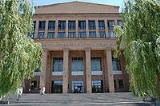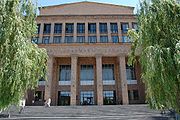
Education in Armenia
Encyclopedia

History of Armenia
Armenia lies in the highlands surrounding the Biblical mountains of Ararat. The original Armenian name for the country was Hayk, later Hayastan , translated as the land of Haik, and consisting of the name Haik and the suffix '-stan' ....
, Armenia
Armenia
Armenia , officially the Republic of Armenia , is a landlocked mountainous country in the Caucasus region of Eurasia...
made uneven progress in establishing systems to meet its national requirements in social services. Education
Education
Education in its broadest, general sense is the means through which the aims and habits of a group of people lives on from one generation to the next. Generally, it occurs through any experience that has a formative effect on the way one thinks, feels, or acts...
, held in particular esteem in Armenian culture
Culture of Armenia
The culture of Armenia encompasses many elements that are based on the geography, literature, architecture, dance, and music of the people. The culture is similar to and yet distinct from many of the bordering countries like Russia, Georgia and Iran as well as Mediterranean nations such as Greece...
, changed fastest of the social services, while health and welfare services attempted to maintain the basic state-planned structure of the Soviet era.
A literacy rate of 100% was reported as early as 1960. In the communist era, Armenian education followed the standard Soviet model of complete state control (from Moscow
Moscow
Moscow is the capital, the most populous city, and the most populous federal subject of Russia. The city is a major political, economic, cultural, scientific, religious, financial, educational, and transportation centre of Russia and the continent...
) of curricula and teaching methods and close integration of education activities with other aspects of society, such as politics, culture, and the economy. As in the Soviet period, primary
Primary education
A primary school is an institution in which children receive the first stage of compulsory education known as primary or elementary education. Primary school is the preferred term in the United Kingdom and many Commonwealth Nations, and in most publications of the United Nations Educational,...
and secondary education
Secondary education
Secondary education is the stage of education following primary education. Secondary education includes the final stage of compulsory education and in many countries it is entirely compulsory. The next stage of education is usually college or university...
in Armenia is free, and completion of secondary school is compulsory
Compulsory education
Compulsory education refers to a period of education that is required of all persons.-Antiquity to Medieval Era:Although Plato's The Republic is credited with having popularized the concept of compulsory education in Western intellectual thought, every parent in Judea since Moses's Covenant with...
. In the early 1990s, Armenia made substantial changes to the centralized and regimented Soviet system. Because at least 98 % of students in higher education
Higher education
Higher, post-secondary, tertiary, or third level education refers to the stage of learning that occurs at universities, academies, colleges, seminaries, and institutes of technology...
were Armenian, curricula began to emphasize Armenian history and culture
Culture of Armenia
The culture of Armenia encompasses many elements that are based on the geography, literature, architecture, dance, and music of the people. The culture is similar to and yet distinct from many of the bordering countries like Russia, Georgia and Iran as well as Mediterranean nations such as Greece...
. Armenian
Armenian language
The Armenian language is an Indo-European language spoken by the Armenian people. It is the official language of the Republic of Armenia as well as in the region of Nagorno-Karabakh. The language is also widely spoken by Armenian communities in the Armenian diaspora...
became the dominant language of instruction, and many schools that had taught in Russian
Russian language
Russian is a Slavic language used primarily in Russia, Belarus, Uzbekistan, Kazakhstan, Tajikistan and Kyrgyzstan. It is an unofficial but widely spoken language in Ukraine, Moldova, Latvia, Turkmenistan and Estonia and, to a lesser extent, the other countries that were once constituent republics...
closed by the end of 1991. Russian was still widely taught, however, as a second language.
In the 1990-91 school year, the estimated 1,307 primary and secondary schools were attended by 608,800 students. Another seventy specialized secondary institutions had 45,900 students, and 68,400 students were enrolled in a total of ten postsecondary institutions that included universities. In addition, 35 % of eligible children attended preschools. In the 1988-89 school year, 301 students per 10,000 population were in specialized secondary or higher education, a figure slightly lower than the Soviet average. In 1989 some 58 % of Armenians over age fifteen had completed their secondary education, and 14 % had a higher education. In 1992 Armenia's largest institution of higher learning, Yerevan State University
Yerevan State University
Yerevan State University is a university in Yerevan, Armenia. Founded on May 16 1919, it is the largest university in the country with 110 departments. Of its 3,150 employees, 1,190 comprise the teaching staff which includes 25 academicians, 130 professors, 700 docents , and 360 assistant lecturers...
, had eighteen departments, including ones for social sciences, sciences, and law. Its faculty numbered about 1,300 teachers and its student population about 10,000 students. The Yerevan Architecture and Civil Engineering Institute was founded in 1989.
On the basis of the expansion and development of Yerevan State University a number of higher educational independent Institutions were formed including Medical Institute separated in 1930 which was set up on the basis of medical faculty. In 1980 Yerevan State Medical University was awarded one of the main rewards of the former USSR - the Order of Labor red Banner for training qualified specialists in health care and valuable service in the development of Medical Science.
In 1995 YSMI was renamed to YSMU and since 1989 it has been named after Mkhitar Heratsi, the famous medieval doctor. Mkhitar Heratsi was the founder of Armenian Medical school in Cilician Armenia. The great doctor played the same role in Armenian Medical Science as Hypokratus in Old Greek, Galen in Roman, Ib Sina in Arabic medicine.
Foreign students' department for Armenian Diaspora established in 1957 later was enlarged and the enrollment of foreign students began.
Nowadays the YSMU is a Medical Institution corresponding to international requirements, trains medical staff not only for Armenia and neighbor countries, i.e. Iran, Syria, Lebanon, Georgia but for many other leading countries all over the world. A great number of foreign students from India, Nepal, Sri Lanka, the USA and Russian Federation study together with Armenian students. Nowadays the university is ranked among famous higher Medical Institutions and takes its honorable place in the World Directory of Medical schools published by the WHO.
Other schools in Armenia include the American University of Armenia
American University of Armenia
The American University of Armenia is a private, nonsectarian, independent university founded in 1991 in Yerevan, Armenia. Its creation inspired in the aftermath of the 1988 Leninakan Earthquake, the university is the first Armenian institution modeled on Western-style higher education, committed...
, QSI International School of Yerevan
QSI International School of Yerevan
The QSI International School of Yerevan is an international school in Yerevan, Armenia and part of the Quality Schools International group. It is an independent, coeducational day school which offers an educational program to children of all nationalities ages 3 to 18...
and Eurasia International University (EIU). EIU is a private higher education institution established in Yerevan, the Republic of Armenia, in 1996. On March 13, 1997 EIU was fully accredited based on the decision made by the Ministry of Science and Education of the RA. Since then EIU was authorized to issue State Diplomas. Starting from September 2007 Eurasia International University has fully conformed to the requirements of Bologna Process.
Student absenteeism
According to two studies carried out with the help of UNICEF – "Child Labour in Armenia" and "School Wastage Focusing on Student Absenteeism in Armenia" – a rapidly growing student absenteeism and drop out rate are closely linked to child labor as well as the quality of education in Armenia. Between 2002 and 2005 school dropout rates grew at the rate of 250% a year. In 2002-2003 total dropouts were 1,531 students; in 2004-2005 this number increased to 7,630.See also
- Armenian-language schools outside ArmeniaArmenian-language schools outside Armenia-Armenian Weekend Schools:* -Armenian Elementary Schools:* * * Armenian Sisters Academy * * *...

